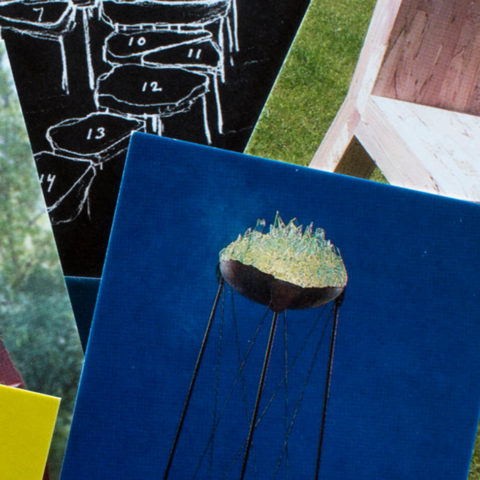catalogue of business cards | visitecatalogusje

Albert Geertjes’ meubels zijn vaak een soort collages/assemblages, je kunt ze gemakkelijk ‘lezen’. Zo wil ik het boekje ook maken: een boekblok tussen twee platten van dik karton zonder de rug waarmee we normaliter verhullen hoe het in elkaar steekt. De voorkant toont een kistje (een vaasje), de achterkant de titel: Dit is een catalogus en zo is het met het binnenwerk ook. Het begint als een plaatjesboek om halverwege over te gaan in een tekstboek: beeld en toelichtende tekst zijn rigoureus van elkaar gescheiden. Dit wordt in het tekstdeel nog een keer doorgezet, nu in een tweedeling links (Nederlandstalig) en rechts (Engelstalig). Het expliciet benoemen: Dit is …, wat Albert ook op enkele van zijn meubels doet, duikt in het boekje op: er is gebruik gemaakt van vier verschillende papiersoorten en op elk katern staat vermeld op welke papiersoort het is gedrukt. Achterin, en daar hoort het eigenlijk ook omdat het het laatst wordt geschreven: het voorwoord.
Albert Geertjes’ furniture often appears to have a certain collage/assemblage quality to it, allowing his work to be easily ‘read’. That was exactly what I wanted this booklet to look like as well: just a book block between two boards of thick cardboard, for once deliberately leaving the book’s spine uncovered for everyone to see. The front cover features a small wooden box (actually a vase), the back cover the book’s title: This is a catalogue. The book’s interior is designed similarly. Starting off as a picture book, it turns into a text book halfway through: image and explanatory text are thus rigorously separated from each other. This idea is then also continued in the rest of this textual section itself, now by dividing the text in a left (Dutch) and a right part (English). The notion of explicitly calling things by their name (like This is …) – something Albert himself has done too by literally ‘labelling’ some of his furniture designs in this way – is also reflected within the booklet: each section carries the name of the paper type (of the four different ones used) on which it is printed. The last page of the booklet contains the preface, which is indeed where it belongs because it is actually always the last part of a book that is written.